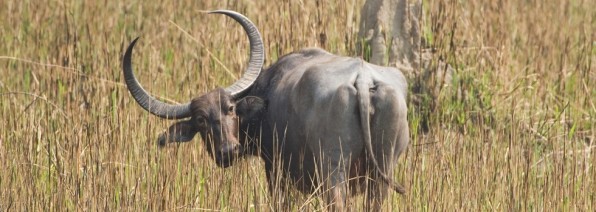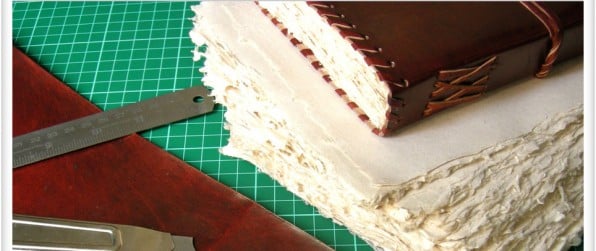Paul Francis: HOW YOUR BOOK WAS MADE
- It begins with choosing the leather hides. This is the difficult part! I hate the idea of animals suffering and of animals being bred for the purpose of using their skins. That is why I only use hides from mature working animals that have come to the end of their natural life.
I buy hides exclusively in India – because in India there is a reverence for cows and buffaloes, and the animals are not maltreated and regarded as a commodity.
- I cut the hide to the approximate size of the cover I am making – and just a little bit bigger. The leather cover will eventually be trimmed with shears after the ‘signatures’ of paper have been stitched into the spine. At this stage I just fold the cover and crease it and punch holes in the spine for the binding.
- I apply a dye to the leather with a brush – in a circular and stipple action. When it is almost dry I rub it down with a rag to absorb residual dye. You might find that some of the dye remains on the surface and stains your fingers the first time you touch the book. This will cease after a while. I could avoid this staining – but I would have to use synthetic dyes and toxic chemicals. No thanks! I prefer to use natural materials that don’t poison our water supply.
- In the case of some books the edge of the cover is stitched with leather thong. Cowhide is too thick for this, so I use goatskin. The thong is cut by scissors in a spiral from the centre of the hide to the outside. It is cut by hand – that is why it varies in thickness along all its length. I hand the cover to someone else for stitching – it takes a long time!
Some books have the corners strengthened by brass trims (solid brass – not plated steel, as cheap plated steel trims eventually rust). - I stitch the signatures of paper into the spine. For this I sometimes use twine. Sometimes I use leather thong.
- I receive the handmade paper ready-cut and bundled in signatures. This paper has been made sheet-by-sheet by a traditional process, from pulped recycled cotton rags. The process uses a lot of water, but it uses no bleach. And with careful management the water can be caught and recycled.
- Finally, I cut the cover so that it is the right distance from the paper all the way round.
- If there is a fastening (tie-strap, buckle, press-stud, c-lock etc) I fit it at this stage.
Then I give the completed book a quick final check. And I wonder who will receive it days or weeks from now and what will they use it for?
I hope, whoever you are, that you find a good use for it and that it brings you happiness.

